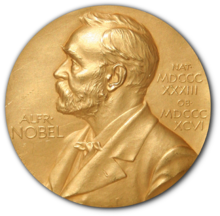| Breakthrough Prize in Fundamental Physics | |
|---|---|
| Awarded for | Accomplishments in fundamental physics broadly defined |
| Presented by | Breakthrough Prize Board |
| Reward(s) | USD$3 million |
| First awarded | 2012 |
| Website | Official Website |
The Breakthrough Prize in Fundamental Physics is one of the Breakthrough Prizes, awarded by the Breakthrough Prize Board. Initially named Fundamental Physics Prize, it was founded in July 2012 by Russia-born Israeli entrepreneur, venture capitalist and physicist Yuri Milner. The prize is awarded to physicists from theoretical, mathematical, or experimental physics that have made transformative contributions to fundamental physics, and specifically for recent advances.
Worth USD$3 million, the prize is the most lucrative physics prize in the world and is more than twice the amount given to the Nobel Prize awardees.
Unlike the annual Breakthrough Prize in Fundamental Physics, the Special Breakthrough Prize is not limited to recent discoveries, while the prize money is still USD$3 million.
Physics Frontiers Prize has only been awarded for 2 years. Laureates are automatically nominated for next year's Breakthrough Prize in Fundamental Physics. If they are not awarded the prize the next year, they will each receive USD$300,000 and be automatically nominated for the Breakthrough Prize in Fundamental Physics in the next 5 years.
Laureates
The following is a listing of the laureates, by year (including Special Prize winners).
New Horizons in Physics Prize
The New Horizons in Physics Prize, awarded to promising junior researchers, carries an award of $100,000.
Trophy

The Fundamental Physics Prize trophy, a work of art created by Danish-Icelandic artist Olafur Eliasson, is a silver sphere with a coiled vortex inside. The form is a toroid, or doughnut shape, resulting from two sets of intertwining three-dimensional spirals. Found in nature, these spirals are seen in animal horns, nautilus shells, whirlpools, and even galaxies and black holes.
Ceremony
The name of the 2013 prize winner was unveiled at the culmination of a ceremony which took place on the evening of March 20, 2013 at the Geneva International Conference Centre. The ceremony was hosted by Hollywood actor and science enthusiast Morgan Freeman. The evening honored the 2013 laureates − 16 outstanding scientists including Stephen Hawking and CERN scientists who led the decades-long effort to discover the Higgs-like particle at the Large Hadron Collider. Sarah Brightman and Russian pianist Denis Matsuev performed for the guests of the ceremony.
Criticism
Some have expressed reservations about such new science mega-prizes.
What's not to like? Quite a lot, according to a handful of scientists... You cannot buy class, as the old saying goes, and these upstart entrepreneurs cannot buy their prizes the prestige of the Nobels. The new awards are an exercise in self-promotion for those behind them, say scientists. They could distort the meritocracy of peer-review-led research. They could cement the status quo of peer-reviewed research. They do not fund peer-reviewed research. They perpetuate the myth of the lone genius.... As much as some scientists may grumble about the new awards, the financial doping that they bring to research and the wisdom of the goals behind them, two things seem clear. First, most researchers would accept such a prize if they were offered one. Second, it is surely a good thing that the money and attention come to science rather than go elsewhere. It is fair to criticize and question the mechanism—that is the culture of research, after all—but it is the prize-givers' money to do with as they please. It is wise to accept such gifts with gratitude and grace.

